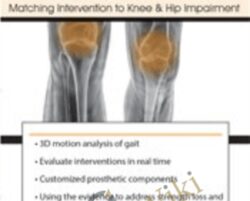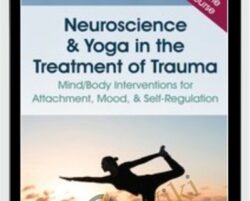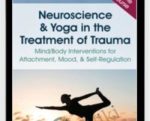Adding this one thing to your talk therapy practice can fast-track the healing process for trauma survivorsDo you sometimes feel like your trauma clients are stubborn and unwilling to change?They make little to no progress in their treatment…Even though you see them consistently and use the talk therapy tools that you know work.This is a common frustration with therapists. And clients.You see, your clients WANT to get better…But they can’t do it with talk therapy alone.Trauma is more than psychological. It’s physicalThe last two decades of neuroscience research proves trauma is stored in the body.Trauma rewires the nervous system…Keeping survivors’ bodies stuck in an exhausting state of fight, where they feel “keyed up,” anxious and overreact to sudden loud noises or crowds.Or, they’re stuck in flight mode, characterized by emotional numbing, depression and disassociation from their bodies.These torturous somatic responses can dominate the body for years after the traumatic event has ended…Making your clients feel like strangers in their own bodies.They have the desire and motivation to heal…But without addressing trauma at the physical level, they’ll always be stuck in that post-traumatic state.For clients to be at peace, you must help them release the physical trauma and once again befriend their body. Discover the ancient practice savvy therapists use to help their clients break free from the crippling grip of trauma……Faster and easier than with talk therapy aloneTalking alone cannot discharge stored emotional memory.Mindful movement, such as yoga, is required to release that stored energy and re-establish the mind-body connection…And you don’t have to be a certified yoga professional—or have super flexibility—to get these benefits in your practice.All you need to get started is this new online course!You’ll get step-by-step instructions to help you integrate yoga as an essential—and effective—part of your client’s healing plan.What Is Yoga and Why Is It Useful in Your Practice?People across the world have been practicing yoga for more than 5 millennia. This is no fad movement.Yoga practitioners use breathwork, mindfulness and physical poses to connect the breath, body and mind to turn the attention inward.This allows a person to recognize habitual thought patterns and cultivate moment-to-moment awareness – which are essential elements of healing.Get Neuroscience & Yoga in the Treatment of Trauma: Mind/Body Interventions for Attachment, Mood, & Self-Regulation – Irina Diyankova & Debra Premashakti Alvis, Only Price $59 Why Yoga Is Effective in Trauma TreatmentYoga helps trauma survivors to:Soothe their anxious minds so they engage in the present moment and tune into their bodiesEmpower themselves to make choices, which trauma often strips from survivorsCreate a positive, compassionate relationship with their body, mind and selfDiscover and use tools for self-regulation and processing sensations and emotionsRelease stored trauma memories so their brain and nervous system can regulateLive safely in their bodies in the presentAnd much moreA recent study of women with chronic, treatment-resistant PTSD revealed that yoga:Significantly reduced the severity of PTSD symptoms,Reduced the incidence of self-harm activities,Decreased dissociative and depressive symptoms, andIncreased the likelihood of loss of PTSD diagnosisAnd this all happened after just 10 yoga sessions.Long-term follow-up of the study revealed that an ongoing yoga practice helped to maintain these benefits.Now you can incorporate elements of this ancient practice into your clinical work to help your clients finally break free from the immobilizing grip of trauma.All you need to get started is the revolutionary new course:In this course, you’ll discover the neuroscience behind yoga as an effective treatment for trauma AND practical exercises and applications you can start using immediately.PART 1: Neuroscience & Yoga in the Treatment of TraumaSection I: Neuroscience, Trauma and YogaSeated Yoga Grounding Practice to Relax and FocusHow your clients experience yoga in the bodyHow to quickly apply this practice to your work with trauma survivorsWhat Is Trauma?Psychological/emotional traumaSingle vs. repeated vs. extended traumaDevelopmental traumaComplex traumaWhat Neuroscience Tells Us about the Impact of TraumaHow and why the brain and nervous system get “stuck” when trying to process a traumatic eventWhy a survivor’s post-trauma autonomic nervous system (ANS) creates narrow “windows of tolerance”—and how yoga can help widen themSimple sitting and standing yoga poses and their clinical applicationsBrain structures implicated in trauma and PTSDHow trauma changes the brain and nervous system—and how they can healSection II: Intersections of Yoga and Trauma TreatmentYoga Poses You Can Use in Individual and Group Work with Trauma SurvivorsMountain Pose to come into the present and release negative emotionsForward Fold soothes an anxious nervous system and encourages introspectionBreath of Joy boosts mood and reduces fatigue and depressionMoving Warrior Poses help to heal shame and increase a sense of control in the bodyDancing Tree Pose encourages balance in the body, which can be difficult for trauma survivors because of changes in their nervous systemAnd more!What Makes Yoga Suitable for the Treatment of TraumaThe triune brain and how yoga calms the amygdala and sympathetic nervous systemHow yoga encourages both top-down and bottom-up regulationWhat yoga is—and is not—and how it can be applied clinicallyDebunking myths and misconceptions about yoga and who it’s forResearch findings on yoga in the treatment of traumaSpecific things to pay attention to when using yoga in treating a trauma survivorIntegrating trauma-sensitive yoga in clinical workPART 2: Bringing Trauma-Informed Yoga into Mental Health Clinical PracticesSECTION I: Using Somatic Experiencing in Your PracticeHow Mindfulness and Yoga Can Help Your ClientsWhat are “bells of mindfulness”How to keep you—and your clients—in the present momentYoga for TraumaWhere the research on yoga and trauma stands right nowWhy yoga as a mind-body-spirit approach is so helpful in treating traumaHow to work with yoga teachers to help clients develop an effective practice in conjunction with clinical treatmentYogic Tradition and NeuropsychologyThe (short) history and purpose of yogaHow trauma—and yoga—affects people at the cellular levelYoga’s effect on heart rate variability (HRV)How yoga improves vagal nerve tone to improve resiliencyEmbodied Psychotherapy and Somatic ExperiencingHow somatic therapy through yoga can stabilize the ANS to reduce anxiety, depression and chronic stressWhat is “shock structure” and how it relates to traumaHow yoga can increase positive experiences in trauma survivorsDiscover strategies that discharge the nervous system and restore a resting baseline in trauma survivorsHow trauma-sensitive yoga differs from other kinds of yogaBreathwork to help calm rising panicSECTION II: Trauma-Informed Yoga in ActionYoga and Self-RegulationWhat the research reveals about how yoga and breathwork helps trauma survivorsUse yogic breathwork to calm and regulate the ANSExamples of yogic breathing exercises you can use with your clientsApplying Trauma-Informed Yoga Postures in Your PracticeHow to use and apply the principles and practices of trauma-informed yogaChair yoga sequences that help your clients discharge trauma in their bodyHow the deep relaxation of yoga nidra can help regulate the ANSEvaluating your clients to ensure this type of treatment is appropriateSuggestions for opening a nd closing sessions with trauma survivorsYou’ll also receive clear, written instructions for all postures and breathwork used throughout the course.Get Neuroscience & Yoga in the Treatment of Trauma: Mind/Body Interventions for Attachment, Mood, & Self-Regulation – Irina Diyankova & Debra Premashakti Alvis, Only Price $59 Tag: Neuroscience & Yoga in the Treatment of Trauma: Mind/Body Interventions for Attachment, Mood, & Self-Regulation – Irina Diyankova & Debra Premashakti Alvis Review. Neuroscience & Yoga in the Treatment of Trauma: Mind/Body Interventions for Attachment, Mood, & Self-Regulation – Irina Diyankova & Debra Premashakti Alvis download. Neuroscience & Yoga in the Treatment of Trauma: Mind/Body Interventions for Attachment, Mood, & Self-Regulation – Irina Diyankova & Debra Premashakti Alvis discount.
 Total Joint Rehabilitation: Matching Intervention to Knee & Hip Impairment – Chad M. Thompson
₹12,616.00
Total Joint Rehabilitation: Matching Intervention to Knee & Hip Impairment – Chad M. Thompson
₹12,616.00
 Swing Trading Reports – M.A.Perry
₹3,486.00
Swing Trading Reports – M.A.Perry
₹3,486.00
Neuroscience & Yoga in the Treatment of Trauma: Mind/Body Interventions for Attachment, Mood, & Self-Regulation – Irina Diyankova & Debra Premashakti Alvis
₹9,130.00






